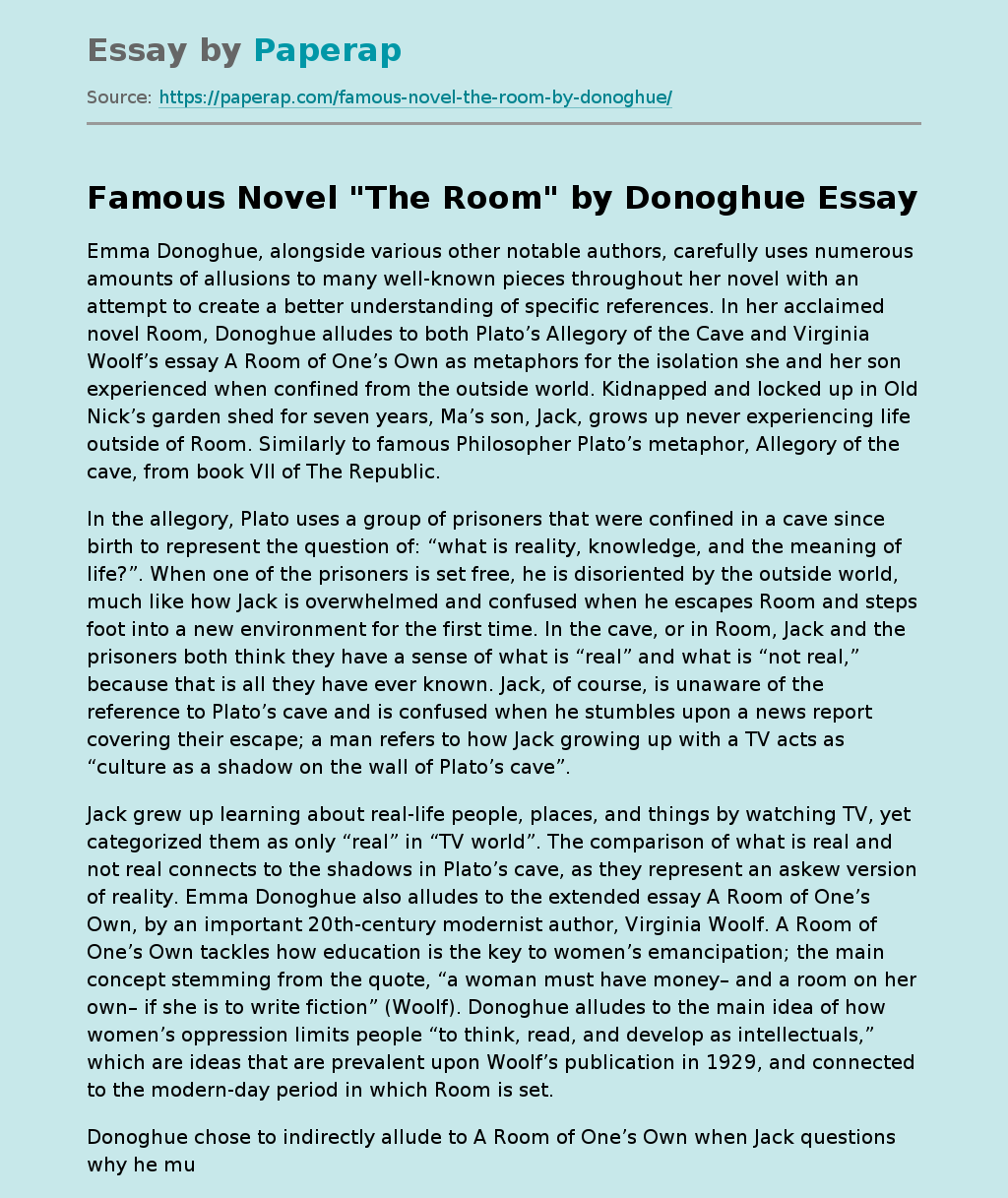Famous Novel "The Room" by Donoghue
Emma Donoghue, alongside various other notable authors, carefully uses numerous amounts of allusions to many well-known pieces throughout her novel with an attempt to create a better understanding of specific references. In her acclaimed novel Room, Donoghue alludes to both Plato’s Allegory of the Cave and Virginia Woolf’s essay A Room of One’s Own as metaphors for the isolation she and her son experienced when confined from the outside world. Kidnapped and locked up in Old Nick’s garden shed for seven years, Ma’s son, Jack, grows up never experiencing life outside of Room.
Similarly to famous Philosopher Plato’s metaphor, Allegory of the cave, from book VII of The Republic.
In the allegory, Plato uses a group of prisoners that were confined in a cave since birth to represent the question of: “what is reality, knowledge, and the meaning of life?”. When one of the prisoners is set free, he is disoriented by the outside world, much like how Jack is overwhelmed and confused when he escapes Room and steps foot into a new environment for the first time.
In the cave, or in Room, Jack and the prisoners both think they have a sense of what is “real” and what is “not real,” because that is all they have ever known. Jack, of course, is unaware of the reference to Plato’s cave and is confused when he stumbles upon a news report covering their escape; a man refers to how Jack growing up with a TV acts as “culture as a shadow on the wall of Plato’s cave”.
Jack grew up learning about real-life people, places, and things by watching TV, yet categorized them as only “real” in “TV world”. The comparison of what is real and not real connects to the shadows in Plato’s cave, as they represent an askew version of reality. Emma Donoghue also alludes to the extended essay A Room of One’s Own, by an important 20th-century modernist author, Virginia Woolf. A Room of One’s Own tackles how education is the key to women’s emancipation; the main concept stemming from the quote, “a woman must have money– and a room on her own– if she is to write fiction” (Woolf). Donoghue alludes to the main idea of how women’s oppression limits people “to think, read, and develop as intellectuals,” which are ideas that are prevalent upon Woolf’s publication in 1929, and connected to the modern-day period in which Room is set.
Donoghue chose to indirectly allude to A Room of One’s Own when Jack questions why he must play in a separate room from his mother in their “Independent Living”, Ma explains, “I read a book at college that said everyone should have a room of their own… to do their thinking in… it would be nice to have somewhere to go that’s just mine…”. Isolated from the world, but never truly alone, Ma is oppressed by Room in the same way Woolf describes the reality regarding how women had to be fully dependent on men for “both the material means and the legal freedom to voice their own ideas”.
Ma is likewise forced on being fully dependent on Old Nick for all needs since she does not have the opportunity to freely care for herself. Emma Donoghue’s choice in using the literary device of allusion to juxtapose Allegory of the Cave and A Room of One’s Own forces readers to think critically about the meaning of isolation. The allusions additionally highlight the complex understanding behind the central theme of confinement, whether it be within a metaphorical cave, a socially-constructed box, or in an 11-by-11-foot room.
Famous Novel "The Room" by Donoghue. (2021, Dec 14). Retrieved from https://paperap.com/famous-novel-the-room-by-donoghue/

